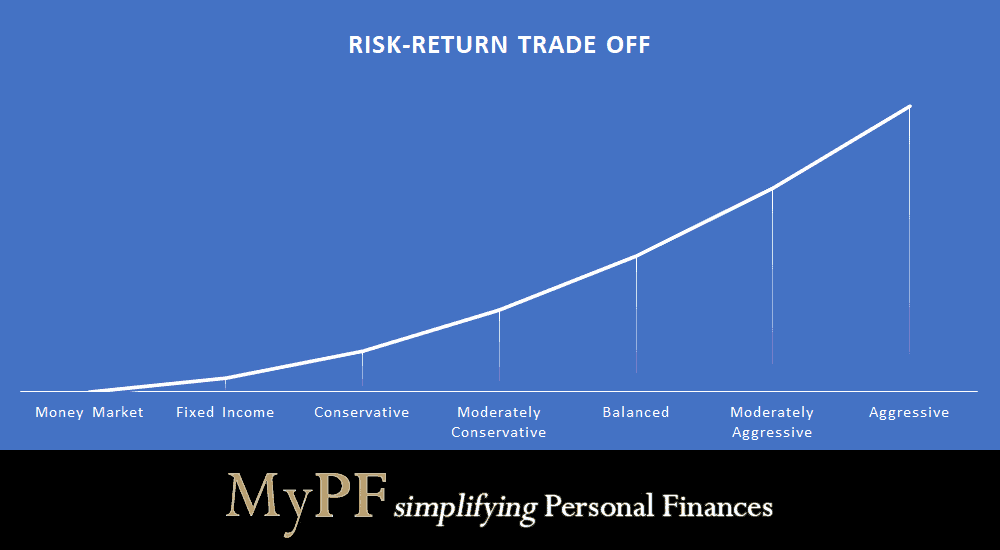Gain insight on what are money market funds and income portfolio. Explore these alternatives to saving accounts and fixed deposits in a low interest rate environment as shared by a licensed financial planner.
Contents
Knowing your alternatives and options
Do you know what alternatives are available to savings accounts and fixed deposits? What investment options are there available to provide income, safety of principal, and liquidity? If you are unsure of your options, the time is ripe for you to learn about money market funds.
Once, I had a client who was strictly about three options when it came to parking his money. Fixed priced Amanah Saham Nasional funds, savings account, and last but not least fixed deposits. He had no idea about other alternative investments that guarantee principal yet offer liquidity.
It is not wrong to have conservative investment preferences. If a client prefers to preserve his nest egg than risk it in search of larger gains, or if he needs funds within the next few months for a down payment on a house or for emergency purposes, a more conservative approach will be recommended. For example, the most conservative allocation would be 100% investment in savings account or fixed deposits.
However, savings and fixed deposits have a lower rate of return. Referring to the figure below, as you take on more risk the potential returns are higher as well. Depending on your financial goals, you will want to find the right type of investments that meets your priorities. Below we will be exploring low risk investments that may serve as a good alternative to savings and fixed deposits while providing better returns and not taking on too much risk.

Malaysia’s interest rate and our economy
It would be remiss to talk about returns from savings and fixed deposits without covering interest rates briefly. Essentially, the interest rate is a cost of money. It is the price you pay when to borrow money and the reward you receive when you lend it to someone else. In Malaysia, Bank Negara Malaysia (BNM) uses the monetary policy to reduce official interest rates when economy growth is too slow and spur the economy.
We are in the fourth consecutive reduction of Overnight Policy Rates (OPR) by Bank Negara Malaysia in the year 2020 itself. It is the lowest rate in 16 years to a record low of 1.75% bps. Some economists predict the OPR will be cut again in late 2020, when the moratorium ends in September.
A look at the state of fixed deposits
Bank regularly promote fixed deposits (FD) to the customers with different tenure of offerings. Fixed deposits are a financial instrument from banks providing FD holders with higher returns than a normal saving account. For more information on FD, you can refer to this fixed deposit article.
FD rates are affected by BNM base rate which is different depending on the bank. Some 3 months or 1 year. Current practices of relying on fixed deposits may not relevant anymore.
“Inflation rate on CAGR (compound annual growth rate) 1985 and 2019 is about 2.5% per annum. Therefore, putting all the money in FD now would mean the depositors will likely be worse off as the returns are not able to offset the inflation rate.” ~Dr Mohd Afzanizam Abdul Rashid, Chief Economist Bank Islam Malaysia
You may be slightly disappointed if you hope for favorable returns in FD, compared to previous years, with the lower interest rate scenario. A lower interest rate also sees lower deposits in banks which would like to lock in your deposits for a period of time by offering FD products. However, with the current economic situation due to Covid-19, many Malaysians have opted to save in saving accounts or even not make steady deposits to the bank due to loss of income from pay cuts or retrenchment. At the same time, lower interest rate also encourage loan borrowings to individuals and businesses.
Options for portfolio management
Choosing the right fund has never been easy no matter your risk appetite. There are alternatives other than placing your money in savings accounts or FD for returns. An alternative that is increasingly popular is portfolio management which relies on technology, a professional fund management team or both to carefully build a portfolio.
No two person’s investment risk profile and investment mix are exactly the same. Having the right investment mix and asset allocation is dependent on a person’s age, retirement goals time frame to access the money, and measures to determine how comfortable one is with risk.
A conservative allocation is a good alternative to savings and fixed deposits. This is suitable for scenarios such as:
- Emergency savings
- Retirement expenses for the next 3 to 5 years
- Short time savings for a goal in the next 1 to 2 years
This can be done with a portfolio which is conservative and fairly liquid. This helps one make sure funds are largely secure with very low risk to capital but still requiring a measure of growth to outpace inflation. An income portfolio can be setup with the majority (ranging from 40-80%) of funds in money market funds and the remainder in fixed income assets such as high grade bonds.
Key differences between money market VS fixed income funds
Money market and fixed income funds are unit trust funds which are a collective investment scheme operated by an investment company. The investment company raises money from investors and the fund manager invests in a group of assets in accordance to a set of objectives. As in the earlier figure, money market and fixed income funds in the lowest risk categories.
Money market funds are invested in bank deposits and short term placements with less than one year to maturity. In short, money market funds invest in liquid, low risk money market instruments that are in effect short-term deposits (loans) to banks. Some money market funds specialize in or invest only in government securities. These are generally very low-risk funds offering modest returns around the rate of fixed deposits.
On the other hand, fixed income funds invest in debt securities like bonds, debentures, mortgages that pay regular interest, or in preference shares of companies which pay regular dividends. The goal is to provide investors a regular income stream with low risk. Fixed income funds can generate higher returns by taking on slightly more risk.
A portfolio approach can take the best of both money market funds and fixed income instruments to build a robust portfolio with returns better than fixed deposits and savings accounts while remaining fairly liquid and low risk.
Consider contacting a licensed financial planner to create an asset allocation which helps you:
- Create a disciplined portfolio approach to investing and take advantage of dollar cost averaging.
- Reduce the time taken to decide on investment choices and regular rebalancing.
- Reduce portfolio risk through diversification across different asset classes, sectors and markets.
There is no ‘one-size-fits-all’ strategy and therefore, your licensed financial planner would be able to construct one, in line with your own perimeters.
You May Also Like
- 5 Alternatives to Fixed Deposits
- 5 Questions People Ask on Investing
- 6 Investing Fallacies and Biases to Avoid
- Engage a Financial Advisor When Investing in Unit Trusts
- MyPF Guide to Investing
Are you placing funds in a money market fund or an income portfolio?





Leave A Comment